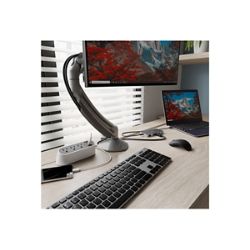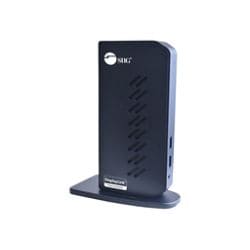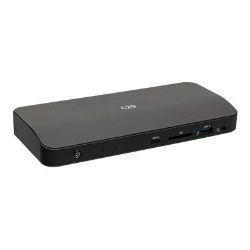September 19, 2022
Docking Stations and Port Replicators – Not as Different as You Think
Evolving technologies are mitigating key differences between these workstation platforms and increasing value.
There was a time not too long ago when there were clear differences between docking stations and port replicators. These two work platform options supported different functions in the enterprise. But more recently, innovations in port connector technology have narrowed the differences between them. Understanding these differences and the user situations that they support is essential to making a smart purchase decision.
“Historically, docking stations have had unique ports on them, proprietary ports,” explains Ryan Dow, Lenovo brand manager at CDW. “Docking stations power the device with one cord, which makes it unique. And the station connects you to all the other peripherals. With port replicators, you connect your laptop to a port and are then connected to all sorts of peripherals through the other ports on the unit, but you traditionally you can’t power your laptop through this connection.”
“Docking stations are a good fit for professionals that do some travel but also need a desk in the office,” explains Justin Kring, HP senior brand manager at CDW. “A big selling point on the docking station is the ability to access two monitors, which doubles productivity. But if the user is more travel-focused, just needing a spot to access email and other communication tools, a port replicator may be a better setup for them.”
The Arrival of USB-C and Thunderbolt 3
These very defined use cases for docking stations and port replicators were the norm until the connector technology began to improve with the introduction of USB-C and Thunderbolt 3 connector systems on laptops rolling out in 2015. These new technologies have been quickly embraced by manufacturers and users.
“Both docking stations and port replicators are moving away from standard USB,” says Damien D’Amore, a Dell client solution group specialist at CDW. “Manufacturers are upgrading to USB-C or Thunderbolt. Docking stations are moving away from mechanical connections; now it’s often either USB-C or Thunderbolt, one cable connection. These two separate technologies, docks and port replicators, are growing together.”
What’s all the excitement about? With USB-C, it was an upgrade from previous USB connectors. It is a universal connector (replacing a growing number of USB options on the market), driving faster device charging (outputting up to 100 watts of power, but varies among devices) and supporting faster data transfer speeds, topping out at 10Gbps.
Thunderbolt 3 was the first iteration of Thunderbolt technology that used USB connectors (same as USB-C). This allowed for wider adoption beyond the Apple laptop niche that it was relegated to following its introduction in 2011. Thunderbolt 3 delivers even faster data transfers speeds of up to 40Gbps. It supports a wider range of protocols, such as DisplayPort, allowing a single cable to connect to two 4K video displays compared to USB-C’s single 4K display support. In addition, Thunderbolt 3 allows up to six devices to be daisy-chained together.
“Thunderbolt can drive power to the laptop,” explains D’Amore. “That’s a consideration. All these new Thunderbolt setups also get software improvements and updates. So that’s a big plus, keeping that technology up to date.”
“For the average consumer with common computing needs, USB-C is a good fit,” advices D’Amore. “Others are seeking Thunderbolt, users with specific technical or visual support needs. But most people are satisfied with the increased data speeds that USB-C offers.”
Learn more about USB-C vs. Thunderbolt 3.
Choosing Between USB-C and Thunderbolt 3
The key difference when comparing the two connector options is that Thunderbolt 3 supports faster data and video transfer. And it’s worth pointing out that any USB-C device plugged into a Thunderbolt 3 port will function, but Thunderbolt 3 devices will not function if plugged into a USB-C port.
“With USB-C and Thunderbolt docking stations — it’s a one-cord setup, which users like,” says D’Amore. “That, along with more desk-sharing arrangements, is driving port replication sales. As more companies go to hoteling, they’re often going to port replicators like these.”
Because of Thunderbolt 3’s unique support needs, it is important for organizations to really do their homework to make sure they have everything in place to take advantage of its advanced features.
“There aren’t a lot of prebuilt Thunderbolt laptops, so if that’s of value, that needs to be clarified right off the bat during purchase consideration,” says D’Amore. “Thunderbolt requires certain processors on the laptop, which support the higher data speeds and the charge.”
|
USB-C |
Thunderbolt 3 |
Data Speed |
10Gbps |
40Gbps |
Power Delivery |
100 watts |
100 watts |
Daisy Chain |
N/A |
Up to 6 devices |
Cross-compatibility |
Cannot run over Thunderbolt 3 |
Can run over USB-C |
4K Display Support |
1 display |
2 displays |
Merging Technologies
With these changes to the connector technology, docking stations and port replicators are becoming less distinct. The ability to run power over a Thunderbolt 3 connection, to essentially provide port replicators with one cord to do it all, makes it harder to separate these two workstation options. But docking station manufacturers (typically the same companies building the laptops) are building a stronger case for their products to better compete with third-party port replicator manufacturers.
“Manufacturers are guaranteeing that their dock stations will be good for several years going forward, based on this change to port replicators,” says Dow. “With docking stations, change is slow. They are typically around and usable for five years or so. They’re standardized for a while. You can use the same docking station, as long as you are upgrading on the same model and manufacturer. So, if you’re upgrading laptops every year, you’ll be able to use the same docking station for several years without replacing.”
Choosing the Right One
Which option is the best fit for you? The traditional use cases — docking stations for the everyday office user that has lots of peripherals, port replicators for hoteling situations where users need quick and easy network access — mostly hold true. “With a lot of companies, you’ll see a range of options within their offices, a mix of port replicators and docking stations,” explains Kring.
“Port replicators are often third party, so you need to do your homework to get your specific laptop and peripheral connection needs met,” says D’Amore. “With a docking station, it’s from the same brand and is built specifically for the needs of your laptop, which easily addresses those questions about compatibility — there’s not guessing. And port replicators tend to not last as long as a docking stations.”
Looking beyond the use cases, there are several other drivers that are influencing a purchase decision.
“Honestly, I don’t think the question of docking station or port replicator is a purchase consideration when looking at laptops,” offers Dow. “It’s more what the purchaser is told to buy by the IT team. IT is figuring out what works best for their environment. The displays in use are a huge part of that equation. Potential setups can include two or three displays, 1080dp resolution or something different, VGA, HMI – display connection options often drive the choice of laptop. Those questions ultimately drive what docking station or port replicator to pursue.”
D’Amore suggests the same. “A lot of the decision-making is driven by choice of monitors — what does the company want users to connect and daisy-chain to. The ability to connect the laptop to certain peripherals, they may need Thunderbolt, they may need something that supports 1080dp. And Thunderbolt comes in 1800-watt or 240-watt docking compatibility. So that’s a determiner. What is the organization trying to drive and connect to?”
“Where do you want to be at with the price point?” D’Amore says. “Does it provide the charge you need? What’s the resolution monitor support? Those are the big three questions you need to ask.”





